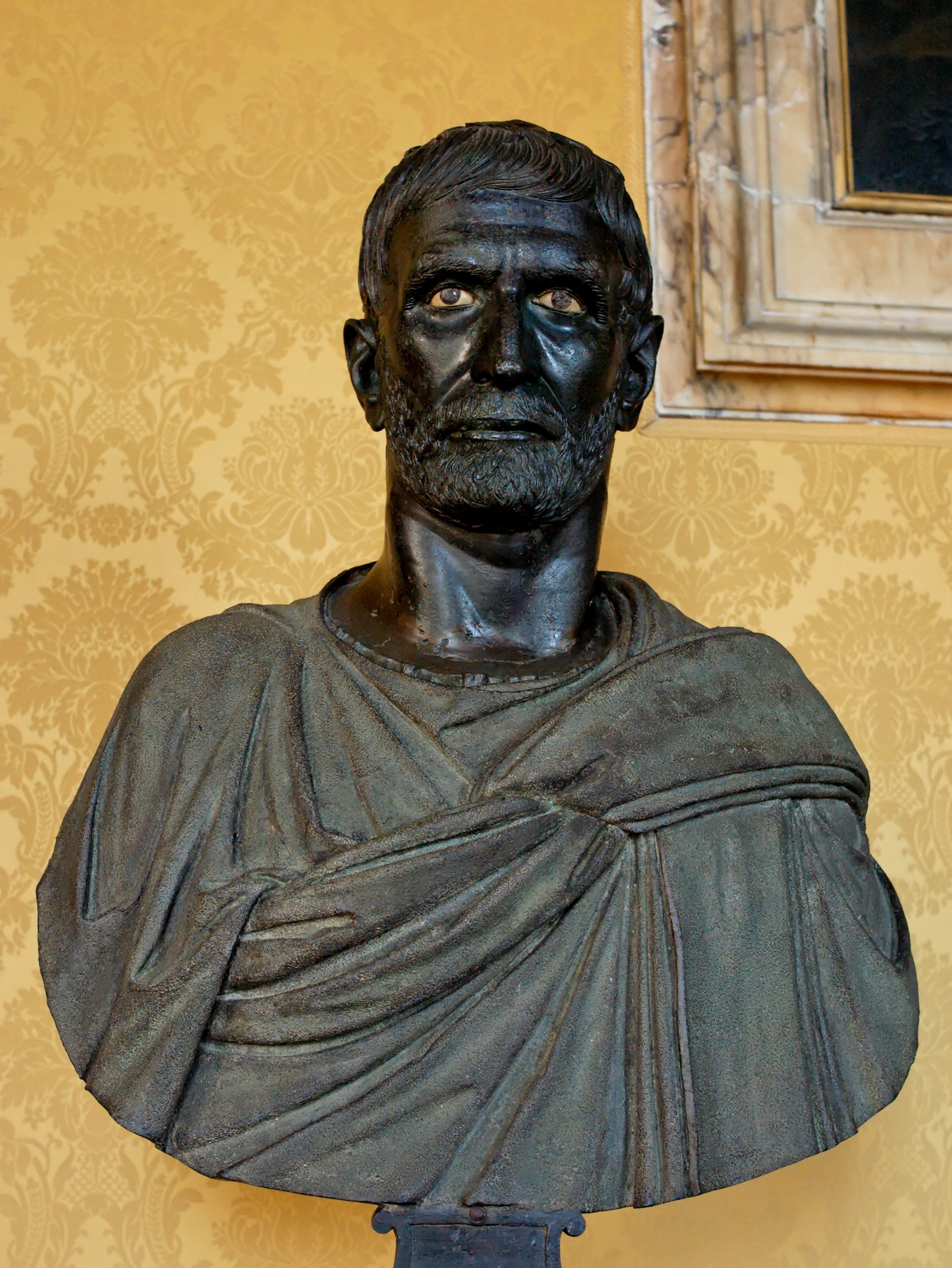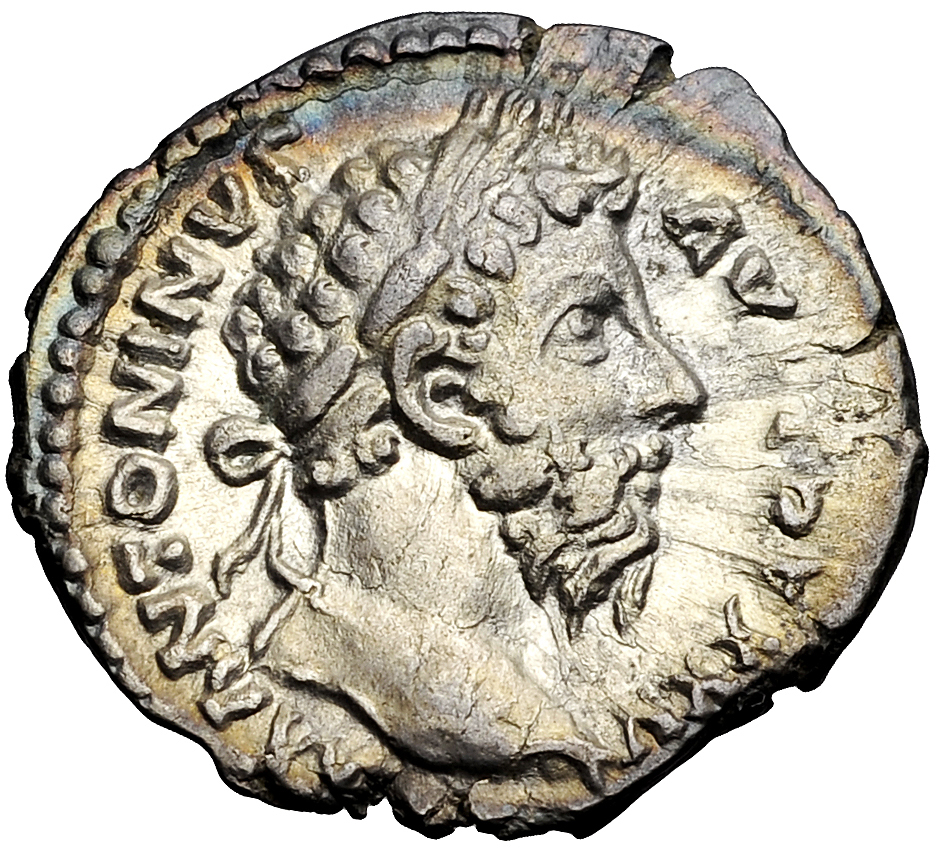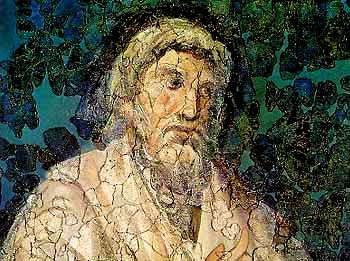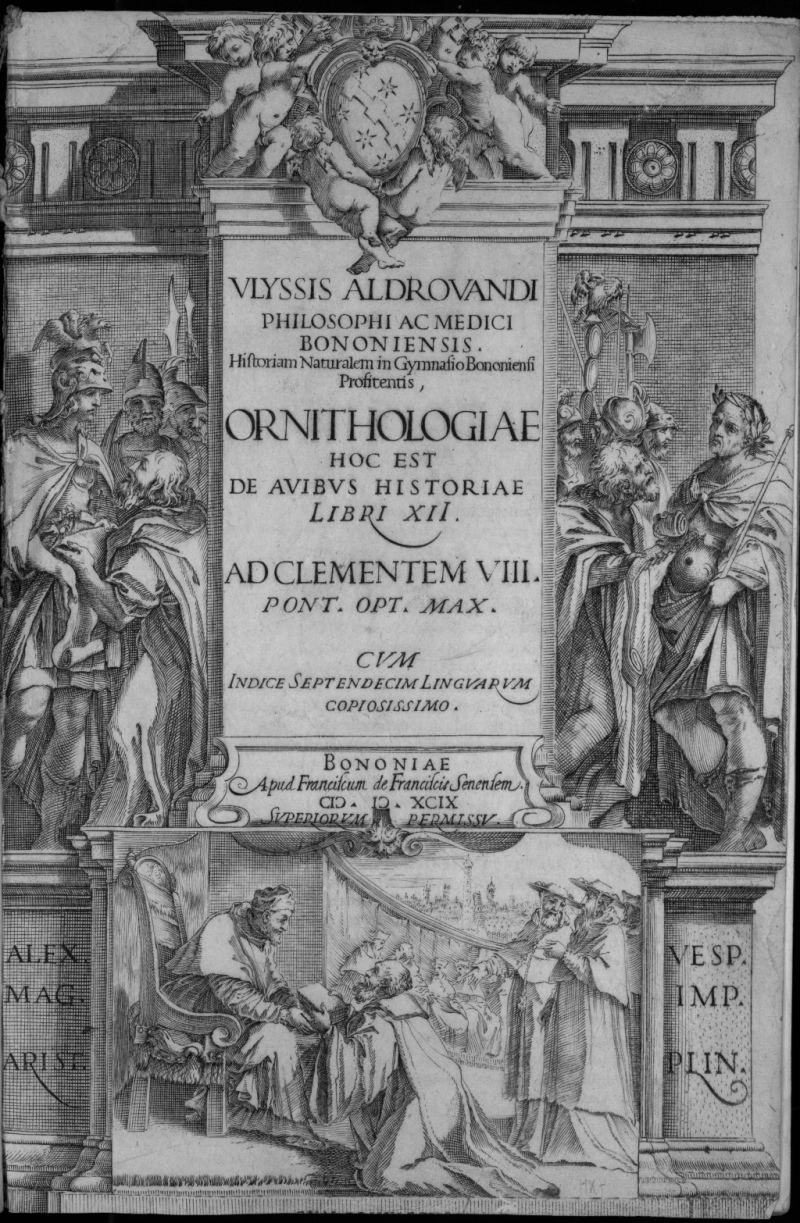|
Capitoline Brutus
The Capitoline Brutus is an ancient Roman bronze bust commonly thought to depict the Roman consul Lucius Junius Brutus (d. 509 BC), usually dated to the late 4th to early 3rd centuries BC, but perhaps as late as the 2nd century BC, or early 1st century BC. The bust is 69 cm (27 in) in height and is currently located in the Hall of the Triumphs within the Capitoline Museums, Rome. Traditionally taken to be an early example of Roman portraiture and perhaps by an Etruscan artist influenced by Hellenistic art and contemporary Greek styles of portraiture, it may be "an archaizing work of the first century BC". The Roman head was provided with a toga-clad bronze bust during the Renaissance. History The bust was discovered in Italy during the 16th century. In 1564 it was bequeathed to the city of Rome by Cardinal Rodolfo Pio da Carpi. Its identification as a representation of the ancient Roman statesman Lucius Junius Brutus was first formulated by antiquarians who excavated a ... [...More Info...] [...Related Items...] OR: [Wikipedia] [Google] [Baidu] |
Capitoline Brutus Musei Capitolini MC1183 04
The Capitolium or Capitoline Hill ( ; it, Campidoglio ; la, Mons Capitolinus ), between the Forum and the Campus Martius, is one of the Seven Hills of Rome. The hill was earlier known as ''Mons Saturnius'', dedicated to the god Saturn. The word ''Capitolium'' first meant the temple of Jupiter Optimus Maximus later built here, and afterwards it was used for the whole hill (and even other temples of Jupiter on other hills), thus ''Mons Capitolinus'' (the adjective noun of ''Capitolium''). In an etymological myth, ancient sources connect the name to ''caput'' ("head", "summit") and the tale was that, when laying the foundations for the temple, the head of a man was found, some sources even saying it was the head of some ''Tolus'' or ''Olus''. The ''Capitolium'' was regarded by the Romans as indestructible, and was adopted as a symbol of eternity. By the 16th century, ''Capitolinus'' had become ''Capitolino'' in Italian, and ''Capitolium'' ''Campidoglio''. The Capitoline H ... [...More Info...] [...Related Items...] OR: [Wikipedia] [Google] [Baidu] |
Maarten Van Heemskerck
Maarten van Heemskerck or ''Marten Jacobsz Heemskerk van Veen'' (1 June 1498 - 1 October 1574) was a Dutch portrait and religious painter, who spent most of his career in Haarlem. He was a pupil of Jan van Scorel, and adopted his teacher's Italian-influenced style. He spent the years 1532–6 in Italy. He produced many designs for engravers, and is especially known for his depictions of the Wonders of the World. Biography Early life Heemskerck was born in the village of Heemskerk, North Holland, halfway between Alkmaar and Haarlem. He was the son of a farmer called Jacob Willemsz. van Veen. According to his biography by Karel van Mander, he began his artistic training with the painter Cornelius Willemsz in Haarlem, but was recalled to Heemskerk by his father to work on the family farm. However, having contrived an argument with his father he left again, this time for Delft, where he studied under Jan Lucasz, before moving on to Haarlem, where he became a pupil of Jan van Scorel ... [...More Info...] [...Related Items...] OR: [Wikipedia] [Google] [Baidu] |
Marcus Junius Brutus
Marcus Junius Brutus (; ; 85 BC – 23 October 42 BC), often referred to simply as Brutus, was a Roman politician, orator, and the most famous of the assassins of Julius Caesar. After being adopted by a relative, he used the name Quintus Servilius Caepio Brutus, which was retained as his legal name. Early in his political career, Brutus opposed Pompey, who was responsible for Brutus' father's death. He also was close to Caesar. However, Caesar's attempts to evade accountability in the law courts put him at greater odds with his opponents in the Roman elite and the senate. Brutus eventually came to oppose Caesar and sided with Pompey against Caesar's forces during the ensuing civil war (49–45 BC). Pompey was defeated at the Battle of Pharsalus in 48, after which Brutus surrendered to Caesar, who granted him amnesty. With Caesar's increasingly monarchical and autocratic behaviour after the civil war, several senators who later called themselves ''liberatores'' (Liberators), ... [...More Info...] [...Related Items...] OR: [Wikipedia] [Google] [Baidu] |
Consul
Consul (abbrev. ''cos.''; Latin plural ''consules'') was the title of one of the two chief magistrates of the Roman Republic, and subsequently also an important title under the Roman Empire. The title was used in other European city-states through antiquity and the Middle Ages, in particular in the Republics of Genoa and Pisa, then revived in modern states, notably in the First French Republic. The related adjective is consular, from the Latin ''consularis''. This usage contrasts with modern terminology, where a consul is a type of diplomat. Roman consul A consul held the highest elected political office of the Roman Republic (509 to 27 BC), and ancient Romans considered the consulship the highest level of the ''cursus honorum'' (an ascending sequence of public offices to which politicians aspired). Consuls were elected to office and held power for one year. There were always two consuls in power at any time. Other uses in antiquity Private sphere It was not uncommon for an ... [...More Info...] [...Related Items...] OR: [Wikipedia] [Google] [Baidu] |
Roman Coin
Roman currency for most of Roman history consisted of gold, silver, bronze, orichalcum and copper coinage. From its introduction to the Republic, during the third century BC, well into Imperial times, Roman currency saw many changes in form, denomination, and composition. A persistent feature was the inflationary debasement and replacement of coins over the centuries. Notable examples of this followed the reforms of Diocletian. This trend continued into Byzantine times. Due to the economic power and longevity of the Roman state, Roman currency was widely used throughout western Eurasia and northern Africa from classical times into the Middle Ages. It served as a model for the currencies of the Muslim caliphates and the European states during the Middle Ages and the Modern Era. Roman currency names survive today in many countries, such as the Arabic dinar (from the ''denarius'' coin), the British pound, and the peso (both translations of the Roman ''libra''). Authority to mint co ... [...More Info...] [...Related Items...] OR: [Wikipedia] [Google] [Baidu] |
Lactantius
Lucius Caecilius Firmianus Lactantius (c. 250 – c. 325) was an early Christian author who became an advisor to Roman emperor, Constantine I, guiding his Christian religious policy in its initial stages of emergence, and a tutor to his son Crispus. His most important work is the ''Institutiones Divinae'' ("The Divine Institutes"), an apologetic treatise intended to establish the reasonableness and truth of Christianity to pagan critics. He is best known for his apologetic works, widely read during the Renaissance by humanists, who called Lactantius the "Christian Cicero". Also often attributed to Lactantius is the poem '' The Phoenix'', which is based on the myth of the phoenix from Egypt and Arabia. Though the poem is not clearly Christian in its motifs, modern scholars have found some literary evidence in the text to suggest the author had a Christian interpretation of the eastern myth as a symbol of resurrection. Biography Lactantius was of Punic or Berber origin, born in ... [...More Info...] [...Related Items...] OR: [Wikipedia] [Google] [Baidu] |
Antiquary
An antiquarian or antiquary () is an fan (person), aficionado or student of antiquities or things of the past. More specifically, the term is used for those who study history with particular attention to ancient artifact (archaeology), artifacts, History of archaeology, archaeological and historic Archaeological site, sites, or historic archives and manuscripts. The essence of antiquarianism is a focus on the empirical evidence of the past, and is perhaps best encapsulated in the motto adopted by the 18th-century antiquary Sir Richard Hoare, 2nd Baronet, Sir Richard Colt Hoare, "We speak from facts, not theory." The ''Oxford English Dictionary'' first cites "archaeologist" from 1824; this soon took over as the usual term for one major branch of antiquarian activity. "Archaeology", from 1607 onwards, initially meant what is now seen as "ancient history" generally, with the narrower modern sense first seen in 1837. Today the term "antiquarian" is often used in a pejorative sense ... [...More Info...] [...Related Items...] OR: [Wikipedia] [Google] [Baidu] |
Ulisse Aldrovandi
Ulisse Aldrovandi (11 September 1522 – 4 May 1605) was an Italian naturalist, the moving force behind Bologna's botanical garden, one of the first in Europe. Carl Linnaeus and the comte de Buffon reckoned him the father of natural history studies. He is usually referred to, especially in older scientific literature in Latin, as Aldrovandus; his name in Italian is equally given as Aldroandi. Life Aldrovandi was born in Bologna to Teseo Aldrovandi and his wife, a noble but poor family. His father was a lawyer, and Secretary to the Senate of Bologna, but died when Ulisse was seven years old. His widowed mother wanted him to become a jurist. Initially he was sent to apprentice with merchants as a scribe for a short time when he was 14 years old, but after studying mathematics, Latin, law, and philosophy, initially at the University of Bologna, and then at the University of Padua in 1545, he became a notary. His interests successively extended to philosophy and logic, which he c ... [...More Info...] [...Related Items...] OR: [Wikipedia] [Google] [Baidu] |
Napoleon Bonaparte
Napoleon Bonaparte ; it, Napoleone Bonaparte, ; co, Napulione Buonaparte. (born Napoleone Buonaparte; 15 August 1769 – 5 May 1821), later known by his regnal name Napoleon I, was a French military commander and political leader who rose to prominence during the French Revolution and led Military career of Napoleon Bonaparte, successful campaigns during the French Revolutionary Wars, Revolutionary Wars. He was the ''de facto'' leader of the First French Republic, French Republic as First Consul from 1799 to 1804, then Emperor of the French from 1804 until 1814 and again in Hundred Days, 1815. Napoleon's political and cultural legacy endures to this day, as a highly celebrated and controversial leader. He initiated many liberal reforms that have persisted in society, and is considered one of the greatest military commanders in history. His wars and campaigns are studied by militaries all over the world. Between three and six million civilians and soldiers Napoleonic Wa ... [...More Info...] [...Related Items...] OR: [Wikipedia] [Google] [Baidu] |
Roman Triumph
The Roman triumph (') was a civil religion, civil ceremony and Religion in ancient Rome, religious rite of ancient Rome, held to publicly celebrate and sanctify the success of a military commander who had led Roman forces to victory in the service of the state or in some historical traditions, one who had successfully completed a foreign war. On the day of his triumph, the general wore a crown of laurel and an all-purple, gold-embroidered triumphal ''toga picta'' ("painted" toga), regalia that identified him as near-divine or near-kingly. In some accounts, his face was painted red, perhaps in imitation of Rome's highest and most powerful god, Jupiter (mythology), Jupiter. The general rode in a four-horse chariot through the streets of Rome in unarmed procession with his army, captives, and the spoils of his war. At Temple of Jupiter Optimus Maximus, Jupiter's temple on the Capitoline Hill, he offered sacrifice and the tokens of his victory to the god Jupiter. In Roman Republic, ... [...More Info...] [...Related Items...] OR: [Wikipedia] [Google] [Baidu] |
French First Republic
In the history of France, the First Republic (french: Première République), sometimes referred to in historiography as Revolutionary France, and officially the French Republic (french: République française), was founded on 21 September 1792 during the French Revolution. The First Republic lasted until the declaration of the First Empire on 18 May 1804 under Napoléon Bonaparte, although the form of the government changed several times. This period was characterized by the fall of the monarchy, the establishment of the National Convention and the Reign of Terror, the Thermidorian Reaction and the founding of the Directory, and, finally, the creation Creation may refer to: Religion *''Creatio ex nihilo'', the concept that matter was created by God out of nothing * Creation myth, a religious story of the origin of the world and how people first came to inhabit it * Creationism, the belief tha ... of the French Consulate, Consulate and Napoleon's rise to power. End of the m ... [...More Info...] [...Related Items...] OR: [Wikipedia] [Google] [Baidu] |
Pius VI
Pope Pius VI ( it, Pio VI; born Count Giovanni Angelo Braschi, 25 December 171729 August 1799) was head of the Catholic Church and ruler of the Papal States from 15 February 1775 to his death in August 1799. Pius VI condemned the French Revolution and the suppression of the Gallican Church that resulted from it. French troops commanded by Napoleon Bonaparte defeated the papal army and occupied the Papal States in 1796. In 1798, upon his refusal to renounce his temporal power, Pius was taken prisoner and transported to France. He died eighteen months later in Valence. His reign of over two decades is the fifth-longest in papal history. Biography Early years Giovanni Angelo Braschi was born in Cesena on Christmas Day in 1717 as the eldest of eight children to Count Marco Aurelio Tommaso Braschi and Anna Teresa Bandi. His siblings were Felice Silvestro, Giulia Francesca, Cornelio Francesco, Maria Olimpia, Anna Maria Costanza, Giuseppe Luigi and Maria Lucia Margherita. His matern ... [...More Info...] [...Related Items...] OR: [Wikipedia] [Google] [Baidu] |











